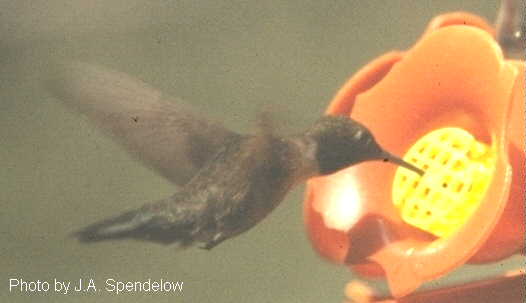Ruby-throated Hummingbird - Archilochus colubris


![]()
Archilochus colubris
Ruby-throated hummingbird
Classification
Phylum: Chordata
Class: Aves
Order: Apodiformes
Family: Trochilidae
Geographic Range
Nearctic, Neotropical: The ruby-throated humming bird is found in central and eastern North America. The species breeds from southern Canada to the Gulf states and winters in Central America and the West Indies.
Physical Characteristics
The back and head of the hummingbird are irridescent green, the underparts are white, and the males' throat is bright red. The ruby-throated hummingbird is extremely small, reaching a length of only three inches.
Natural History
Food Habits
Although the ruby-throated hummingbird will consume insects and spiders, its primary food source is nectar. The ruby-throated hummingbird feeds on several different flowering plants, such as honeysuckle, petunias, nasturiums, and lilacs. It also consumes the sap tha runs from holes made by the yellow-bellied sap sucker. The bird prefers, however, to feed from plants that produce red flowers. Hummingbirds eat twice their body weight each day. While eating, the bird hovers above the plant, using its long beak to suck out the flower's nectar.
Reproduction
The breeding season of the ruby-throated hummingbird begins in March and ends in July, with mid-May being the height of the breeding season. The male returns to the breeding zones and establishes a territory before the females arrive. When the females return, courtship begins with the male flying back and fourth in a perfect arc. During courtship, the hummingbird's wings can beat up to 200 times per second as opposed to the normal 90 beats per second.
The nest of the humming bird is usually built on a narrow limb of a tree and measures one and a half inches across. Alders are often used, as the bird prefers to nest over water. When constructing the nest, the female searches for soft plants such as lichen to build with. A clutch consists of two eggs with an incubation period of 16 days, during which time the mother sits on her nest for about 60-80% of the day. Sometimes, there are two broods per season. The male plays no role in rearing the young and often goes off to find another mate after the eggs hatch.
Behavior
The ruby-throated hummingbird is not especially social. Outside of mating, interaction between two hummingbirds occurs mostly through song. Song is often used by the male to identify and protect territory. One favorite activity of the species is bathing; however, most of the day is spent feeding and defending territory.
The ruby-throated hummingbird migrates during the winter season, crossing almost 2000 miles of land and 600 miles of water over the Gulf of Mexico to settle in Central America. In order to complete this grueling journey, the hummingbird stores a layer of fat eqaul to half of its body weight. The return flight to breeding grounds is timed according to the flowering of food plants in a specific region.
Habitat
During the breeding season, the species can be found in woods, orchards, and gardens. During the winter, the hummingbird inhabits the tropical rainforests of central America.
Biomes: temperate forest & rainforest, tropical rainforest, tropical deciduous forest
Conservation/Biodiversity
Status: no special status.
Due to its small size and its brilliant plumage, the ruby-throated humingbird was hunted for collection during the nineteenth century. Although the species was a great prize, the population never became threatened and the species remains common in its range. Despite there being 338 species of hummingbirds, the ruby-throated humming bird is one out of only four that can be found in the United States.
Economic Benefits for Humans
Positive
The ruby-throated hummingbird aids in pollinating of flowers as it feeds. It plays an important role in pollinating 31 plant species, 21 genera, and 18 plant families.
Other Comments
Hummingbirds are known for their ability to fly backwards, upside down, and to hover. Few other birds share their ability to perform such aerial tricks. They also possess the fewest number of feathers ever counted on a bird. The humming sound of each species is determined by the speed of its wing beats; ruby throats have an extremely rapid wing beat, 78 beats per second. Like other hummingbirds, the ruby-throated hummingbird has an extremely high metabolism that requires about 7000 calories for its average active day of 17 hours (over three times the amount of the required caloric intake for humans).
Pat, Larry and myself saw one in the garden 05/25/97 feeding on a gooseberry blossom.
The Ruby-throated Hummingbird Archilochus colubris is the most common and widely distributed of the hummingbirds in Canada. Its minute size, temperament, and behaviour are fascinating, and its skillful flight and migration are amazing. All these things set it apart among birds.
Appearance
From the tip of its bill to the tip of its tail the ruby-throat measures from 7.5 cm to slightly more than 9 cm. No larger than a good-sized insect, it is often confused with the northern hawk moth, especially at dusk, as the moth is similar in size, form, and flight.
The male ruby-throat is shiny metallic green above and greyish white below and has a forked tail. He wears on his throat a splendid gorget of silky, ruby red feathers, which, depending on how the light strikes it, looks sometimes orange, sometimes jet black. The female is similar but has a greyish white throat patch. Her tail is rounded, and some of the outer tail feathers are marked with white spots. These she often displays when posturing and in flight. The ruby-throat's bill is long, straight, and almost as slender as a darning needle.
Distribution

![]()
![]()
Back to Birds
 Wildflower
Seed For Sale
Wildflower
Seed For Sale